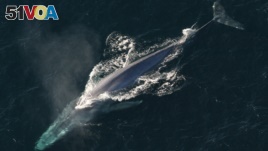01 December, 2019
For the first time ever, scientists have recorded the heart rate of the world's largest creature: the blue whale. To get this reading, they attached an electrocardiogram device to the body of a whale.
They found that the mammal's heart rate can slow to just two beats a minute as the animal searches for food below the surface of the ocean. The highest heart rate they recorded was 37 beats a minute after the whale returned to the surface for air.
The team's study appears online in the publication Proceedings of the National Academy of Sciences.

Blue whales are the largest creature to ever have lived on earth. They are from the baleen whale family; their mouths contain baleen rather than teeth.
The blue whale is the largest animal that has ever lived. It can grow to 30 meters long and weigh as much as 181,000 kilograms. The animal's heart alone weighs more than a fully grown cow.
Stanford University ocean biologist Jeremy Goldbogen led the blue whale heart rate study. He said such research helps scientists understand how massive animals operate.
Generally, larger animals have slower heart rates. A normal human heart of a person at rest beats 60 to 100 times each minute. It increases to about 200 beats a minute during exercise. The smallest mammals, shrews, have heart rates of more than a thousand beats per minute.
The researchers recorded nine hours of information on a 22-meter-long male from the Pacific Ocean off the coast of California. The data did not come easily.
"First, we has to find a blue whale, which can be very difficult" Goldbogen said, because these animals live across massive areas of open ocean. But, with years of research experience and some luck, he explained, the team was able to position a small boat along the whale's left side.
Then, the researchers connected a special recording device to a very long pole. As the whale surfaced to breathe, they quickly deployed the device as near to the animal's heart as possible: just behind its left flipper. The small device had four suction cups on it, permitting it to remain on the whale for several hours.
Blue whales belong to the baleen whale family. These whales are toothless. Instead of teeth, they have baleen, a softer material made from the same substance as fingernails.
To feed, the whales flood their mouths with huge amounts of water and then release it through the baleen. It serves as a filter, trapping krill and other very small sea animals that make up the baleen whale diet.
During feeding dives, the blue whale under observation showed extremely low heart rates, usually of four to eight beats a minute and as low as two beats a minute. After surfacing to breathe after food dives, the whale had heart rates of 25 to 37 beats per minute.
Blue whales have fascinated biologists and people in general for years. They are not only the largest and biggest-brained animals. They are also the loudest. They can communicate with other whales hundreds of miles away.
I'm Caty Weaver.
Reuters News Agency reported this story. Alice Bryant adapted it for VOA Learning English with added information from other sources.
______________________________________________________________
Words in This Story
electrocardiogram – n. a machine that detects and records the electrical activity of the heart
mammal – n. a type of animal that feeds milk to its young and that usually has hair or fur covering most of its skin
diet – n. the food that a person or animal usually eats
flipper – n. one of two flat body parts that stick out from the side of a seal, whale, etc., and are used by the animal for swimming
fascinate – v. to cause (someone) to be very interested in something or someone